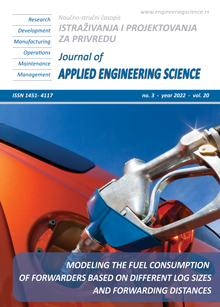COMPUTATIONAL IMPACT PRESSURE OF THE FLOATPLANE’S BOTTOM IN VARIOUS OF DEADRISE AND FLARE ANGLES
Abstract
The water impact at the bottom of a floatplane during landing is one of the main issues related to the structure strength. The free fall of the floater to the water surface is suitable modelling to obtain a pressure value against the optimal design angle of the deadrise and flare. The computational fluid dynamics (CFD) technique under the dynamic mesh feature in FLUENT is applied to compute the impact pressure due to free-falling of the 2D cross-section of the floater in four variation deadrise angles. The simulation results stated that the angle of deadrise affects the pressure on the floater bottom area whose it decreases along with the increase in deadrise angle. The presence of flares also contributes to lowering the pressure value under all deadrise angle conditions. Comparison of simulation results with Wagner’s formula shows a good agreement for all models with an average error of about 5.27%.
References
Sell, C. (2011). Validation of Seaplane Impact Load Theory and Structural Analysis of the Martin 270. M.S. Theses, Department School of Naval Architecture and Marine Engineering, University of New Orleans, New Orleans.
A. A. (2004). Seaplane, skiplane, and float/ski equipped helicopter operations handbook. FAA-H-8083-23, Washington DC.
Milwitzky, B. (1952). Generalized theory for seaplane impact. NACA Technical Report, no. 1103, NACA, USA.
Karman, T. V. (1929) The impact on seaplane floats during landing, NACA Technical Note, no. 321, NACA, USA.
Wagner, H. (1932). The phenomena of impact and planing on water. NACA Translation, no. 1366, NACA, USA.
Chuang, S.L. (1996). Slamming of rigid wedge-shaped bodies with various deadrise angle, Technical Report DTMB-2268, DTMB Washington, USA.
Dobrovol'skaya, Z.N. (1969). On some problems of similarity flow of fluid with a free surface. Journal Fluid Mechanic, vol. 36, no. 4, 805-829, DOI: 10.1017/S0022112069001 996
Greenhow, M. (1987). Wedge entry into initially calm water. Applied Ocean Research, vol. 9, no. 4, 214-223, DOI: 10.10 16/01411187(87)90003-4
Korobkin, A.A., Pukhnachov, V.V. (1988). Initial stage of water impact, Annual Review Fluid Mechanic, vol. 20, 159-185, DOI: 10.1 146/annurev.fl.20.010188.001111
Kapsenberg, G. K. (2011). Slamming of ships: where were we now?. Philosophical Transactions of Royal Society A, vol. 369, no. 1947, 2892-2919, DOI:10.1098/rsta.20 11.0118
Zhao, R., Faltinsen, O.M. (1993). Water entry of two-dimensional bodies. Journal of Fluid Mechanic, vol. 246, 593-612, DOI:10. 1017/S002211209300028X
Faltinsen, O.M. (2005). Hydrodynamics of high-speed vehicles. Cambridge University Press, UK.
Yettou, E. M., Desrochers, A., Champoux, Y. (2007). A new analytical model for pressure estimation of symmetrical water impact of a rigid wedge at variable velocities. Journal of Fluids and Structures, vol. 23, no. 3, 501-522, DOI:10.1016/j.jfluid structs.2006.10.001
Dong, C., Sun, S., Song, H., Wang, Q. (2019). Numerical and experimental study on the impact between a free-falling wedge and water. International Journal of Naval Architecture and Ocean Engineering, vol. 11, no. 1, 233-243, DOI: 1016/j.ijnaoe.2 018.04.004
Yu, P., Ong, M.C., Li, H. (2018). Effects of Added Mass and Structural Damping on Dynamic Responses of a 3D Wedge Impacting on Water. Applied Science, vol. 8, no. 5, 802, DOI: 10.3390/app8050802
Wen, X., Liu, P., Qu, Q., Hu, T. (2020). Impact of wedge bodies on wedge-shaped water surface with varying speed, Journal of Fluids and Structures, vol. 92, 102831, DOI: 1016/j.jfluidstructs.2019.102831
Wang, K., Ma, X., Bai, W., Lin, Z., Li, Y. (2021). Numerical simulation of water entry of a symmetric/asymmetric wedge into waves using OpenFOAM. Ocean Engineering, vol. 227, 108923, DOI: 10.10 16/j.oceaneng.2021.108923
Gudmundsson, S. (2021). General Aviation Aircraft Design: Applied Method and Procedures 2nd Edition, Elsevier Inc., Netherlands.
Aliffrananda, M.H., Sulisetyono, A. (2021). Porpoising Instability Study of the Floatplane during Takeoff Operation on Calm Water. IOP Conference Series: Materials Science and Engineering, vol. 1052,
Aliffrananda, M.H., Sulisetyono, A., Hermawan, Y.A., Zubaydi, A. (2022). Numerical analysis of floatplane porpoising instability at calm water during take-off. International Journal Technology, vol. 13, no. 1, 190-201, DOI: 10.14716/ijtech.v13i1. 4903
Sulisetyono, A., Fadhlurrohman, I., Ali, B., Zubaydi, A. (2022). Computational prediction of the resistance of the the floatplane at various trim angles. Journal of Theoretical and Applied Mechanics, vol. 60, no. 2, 265 – 276, DOI: 10.15632/jtam-pl/148053
Halliday, D., Resnick, R., Walker, J. (2021). Fundamentals of physics 12th edition. John Wiley & Sons, USA.
Code of Federal Regulation (CFR). Aeronautics and space, from https://www. ecfr.gov/current/title-14/chapter-I/subchapt er-C/part-25/subpart-C/subject-group-ECF R99790d9728306e9, 2022-04-15

